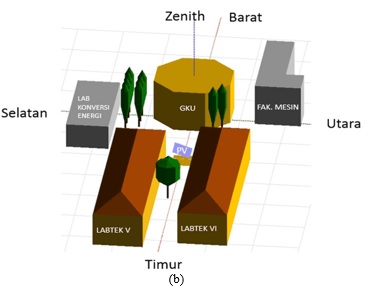Peningkatan Kinerja Modul PV Kanopi dengan Optimasi Pembayangan pada Area Terbatas
Abstract
In this paper, the contribution for finding the tilt and azimuth angle, location, and shift optimum with shading analysis method using PVSyst software has been done. The PV module capacity is 20 kWp that and integrated as canopy in the crosswalk between LABTEK V and LABTEK VI, ITB campus, Bandung. Coodinate from the location of PV modules is 6,89 LS dan 107,61 LT (- 6,89 oS, 107,61 oE). Fixed tilt was used for the PV modules orientation. The buildings and trees around the PV module cause shading effect in the PV modules, therefore, to maximize PV performance additional optimization and shading analysis have to be carried out. Performance achieved tilt angle 11o and azimuth 0o with effective global irradiation 1160,1 kWh/m2/year and energy array 21,75 MWh/tahun. After tilt optimization, shift and array optimization was added for improve the PV modul performance. In the added the shift and array optimization scenarios, the effective global irradiation has improved 72 kWh/m2/year and 14,9 kWh/m2/year respectively and the energy array has improved 1,26 MWh/year and 0,25 MWh/year.
Downloads
References
[2] X. Cao, X. Dai, J. Liu, “Building energy-consumption status worldwide and the state-of-the-art technologies for zero-energy buildings during the past decade,” Energy and Buildings, Volume 128, 2016.
[3] E. Saretta, P. Caputo, F. Frontini, “A review study about energy renovation of building facades with BIPV in urban environment,” Sustainable Cities and Society, Volume 44, 2019.
[4] K. H. Merta, I. N. S. Kumara, W. G. Ariastina, “Rancangan Penempatan Modul Surya dan Simulasi PLTS Fotovoltaik Atap Gedung RSPTN Rumah Sakit Universitas Udayana.” Majalah Ilmiah Teknologi Elektro, [S.l.], v. 18, n. 3, p. 329-336, dec. 2019.
[5] G. Pradika, I. A. D. Giriantari, I N. Setiawan, “Potensi Pemanfaatan Atap Tribun Stadion Kapten I Wayan Dipta Gianyar sebagai PLTS Rooftop.” Majalah Ilmiah Teknologi Elektro, [S.l.], v. 19, n. 2, p. 225-234, dec. 2020.
[6] R. A. Agathokleous, S. A. Kalogirou, “Status, barriers and perspectives of building integrated photovoltaic systems,” Energy, Volume 191, 2020.
[7] A. B. Awan, M. Alghassab, M. Zubair, A.R. Bhatti, M. Uzair, G. Abbas, “Comparative Analysis of Ground-Mounted vs. Rooftop Photovoltaic Systems Optimized for Interrow Distance between Parallel Arrays,” Energies, 2020.
[8] Haq, I., Pradipta, J., Sheba, M., Persada, A., Soelami, F., & Leksono, E. “Simulasi Energi dan Keekonomian Sistem Pembangkit Listrik Tenaga Surya (PLTS) untuk Fungsi Peak Load Shaving pada Bangunan di Lingkungan Kampus ITB.” Journal of Science and Applicative Technology, 2021.
[9] S. S. Alrwashdeh, “Assessment of the energy production from PV racks based on using different Solar canopy form factors in Amman-Jordan,” International Journal of Engineering Research and Technology, Vol. 11, 2018.
[10] Available: www.PVSyst.com [Accessed: Mar. 3rd, 2021]
[11] M. Jumaa, S. Adbar, “Effect of tilt Angle and Azimuth Angle on The Global Irradiance Using The PVSyst Software for Alkhums-Libya,” Alhabit Journal of Applied Sciences, Vol. 1, Issue 1, 2020.
[12] I B K Sugiarianta, I G M M Sunaya, I G N A D Saputra, “Optimization of tilt PV angle on-grid 300 Wp PV plant model at Bukit Jimbaran Bali.” Journal of Physics: Conference Series. 2020.
[13] B. Belmahdi, A. El Bouardi, “Solar Potential Assessment using PVsyst Software in the Northern Zone of Morocco,” Procedia Manufacturing, Volume 46, 2020.
[14] A. Mermoud, “Optimization of row-arrangement in pv systems, shading loss evaluations according to module positioning and connexions,” 27th European Photovoltaic Solar Energy Conference, 2012.
[15] A.A. Babatunde, S. Abbasoglu, M. Senol, “Analysis of the impact of dust, tilt angle and orientation on performance of PV Plants,” Renewable and Sustainable Energy Reviews, Volume 90, 2018.
[16] R. Rachchh, M. Kumar, B. Tripathi, “Solar photovoltaic system design optimization by shading analysis to maximize energy generation from limited urban area,” Energy Conversion and Management, Volume 115, 2016.
[17] M. H. Babikir, D. Njomo, M. Barka, M. Y. Khayal, D. Goron, V. S. Chara-Dackou, T. T. Martial, K. L. D. Romeo, Gram-shou J. P., N. S. Elie, “Modeling the Incident Solar Radiation of the City of N’Djamena (Chad) by the Capderou Method,” International Journal of Photoenergy, 2020.
[18] Handoko R.I., Zul Fakhri, “Optimum tilt angle and near shading analysis for 1000 watt peak photovoltaic application system,” Seminar Nasional Sains dan Teknologi, 2018.
[19] Y. Muñoz, O. Vargas, G. Pinilla, J. Vasquez, “Sizing and Study of the Energy Production of a Grid-tied Photovoltaic System Using PVsyst Software,” TECCIENCIA, 2016.
[20] A. Kaddour, L. Benmebrouk, S. A. Bekkouche, B. Benyoucef, S. Bezari and R. Khenniche, "Improvement of the Stand-Alone PV System Performance by PVSYST Software,” 7th International Renewable and Sustainable Energy Conference (IRSEC), 2019
[21] J. Ranalli, R. Vitagliano, M. Notaro, D. J. Starling, “Sensitivity of shading calculations to horizon uncertainty,” Solar Energy, Volume 144, 2017.
[22] Simulation variables: meteo, irradiance and PV array [Online] Available: https://www.pvsyst.com/help/simulation_variables_meteo.htm. [Accessed: May. 23rd, 2021]
[23] A. Nilsson, “Transparent solar cell techniques, from a solar Irradiance and environmental perspective,” ISSN: 1654-7616, UPTEC E17014, 2017.
[24] T. M. A. Pandria, Muzakir, E. Mawardi, Samsudin, Munawir, Mukhlizar, “Penentuan Sudut Kemiringan Optimum Berdasarkan Energi Keluaran Panel Surya,” Serambi Engineering, Volume VI, No. 1, Januari 2021.
[25] A. D. Afriyani, S. Prasetya, R. Filzi, “Analisis pengaruh posisi panel surya terhadap daya yang dihasilkan di PT Letera Bumi Nusantara,” Prosiding Seminar Nasional Teknik Mesin Politeknik Negeri Jakarta, 2019.
[26] M. Z. Jacobson, V. Jadhav, “World estimates of PV optimal tilt angles and ratios of sunlight incident upon tilted and tracked PV panels relative to horizontal panels,” Solar Energy, Volume 169, 2018.


This work is licensed under a Creative Commons Attribution-NonCommercial-NoDerivatives 4.0 International License.

This work is licensed under a Creative Commons Attribution 4.0 International License




